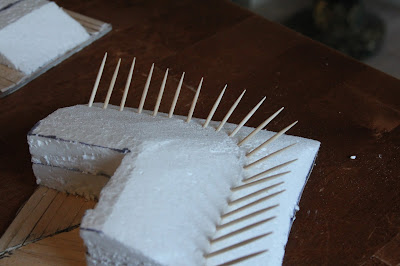There are a wealth of resources online describing the battle and even a re-enactment video available!
Detailed report of the proceedings of the battle
UK Battlefields Resource Centre
Battle of Newburn re-enactment
The forces of the English will comprise of 1500 cavalry and 3000 infantry and the English deployed 400 musketeers and 4 guns to each fort. Extrapolating this to the battlefield can be a bit tricky, but if I give 2 units of muskets and 1 light gun to each fort that hopefully will be accurate enough. I'll give them the "Freshly Raised" -rule to reflect green troops.
This leaves 2200 infantry and 1500 cavalry. The cavalry regiment would comprise of around 600 horse, see examples here, each being split to two functional units. Perhaps 4 units of cavalry could be a nice compromise. The cavalry were staunch and didn't much react to the flight of the green infantrymen, so I feel they would benefit from the "Steady" -rule.
And to distribute the rest of the infantry would be probably easiest to make 2 sets of 1 pike unit and 2 muskets for the English, all "Freshly Raised". The English would have 3 generals, 2 commanding one fort and 2 sets of pike&shotte and the remaining the 4 units of cavalry.
Thus the English force would comprise of:
Commander in Chief Edward, Lord Conway, Ld 8
Infantry General, Ld 8
2 pike (Freshly Raised)
4 musket (Freshly Raised)
2 musket (in fort, Freshly raised)
1 light cannon (in fort)
Cavalry General, Ld 8
4 units of cavalry
Infantry General, Ld 8
2 pike (Freshly Raised)
4 musket (Freshly Raised)
2 musket (in fort, Freshly raised)
1 light cannon (in fort)
Total: 4 pike, 10 musket, 4 cavalry, 2 ordnance.
The Scots themselves are a different matter then. To make the game interesting, they should have around twice the amount of troops. Leslie will be the C-in-C. I vaguely remember reading somewhere that the Scots had around 3000 horse, so let's give them twice the amount of cavalry to be on the safe side, so 8 units of cavalry. No special rules apart from what is in the Covenanters list to begin with. Let's command them with 2 generals.
That leaves around 17000 infantry and a heck of a lot of cannon. A lot certainly, but if we divide the forces so, that the Church has 2 light cannon positioned inside, 2 heavier artillery outside the church (medium, heavy or mortar, I have a medium piece and a mortar, so I'll probably go with them) and 2 sets of pike+shotte guarding the church, commanded by an artillery general, we have 15000-ish infantry left. The rest would possibly be represented by two forces, each led by an infantry general commanding 4 sets of pike& shotte.
This would mean that the Scots forces would be:
Commander in Chief Alexander Leslie, Ld 8
Infantry general, ld 8
4 pike
8 musket
Artillery general, Ld 8
2 light cannon (in church)
1 medium cannon
1 mortar
2 pike
4 musket
Cavalry general, Ld 8
4 cavalry
Cavalry general, Ld 8
4 cavalry
Infantry general, ld 8
4 pike
8 musket
Total: 10 pike, 20 musket, 8 cavalry, 4 ordnance.
So there. Opinions?









































